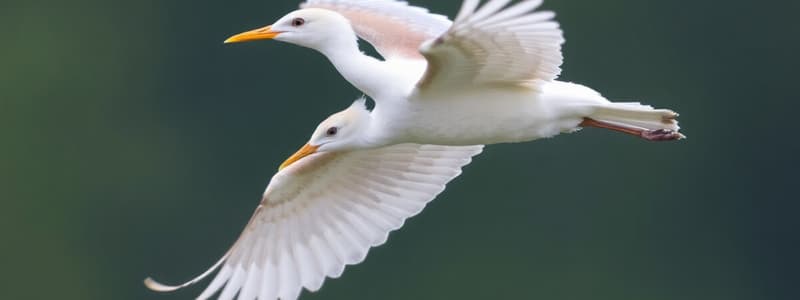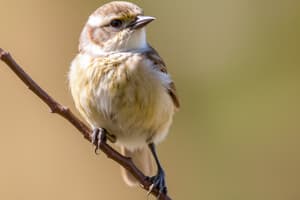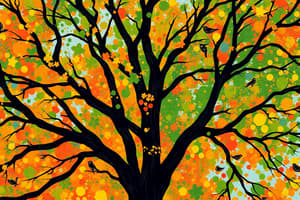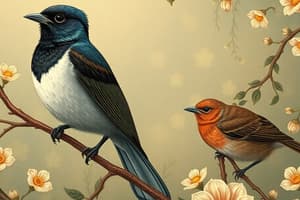Podcast
Questions and Answers
What is a major consequence of habitat fragmentation for bird populations?
What is a major consequence of habitat fragmentation for bird populations?
- Increased nest predation (correct)
- Increased reproductive success
- Increased dispersal opportunities
- Decreased mortality rates
Which species was driven towards extinction primarily due to habitat loss and hunting?
Which species was driven towards extinction primarily due to habitat loss and hunting?
- New Zealand Moa
- Ivory-billed Woodpecker
- California Condor
- Passenger Pigeon (correct)
How do corridors benefit birds in fragmented landscapes?
How do corridors benefit birds in fragmented landscapes?
- They create new territories.
- They provide nesting habitats.
- They assist in gene flow. (correct)
- They eliminate edge effects.
What has been a successful strategy for species near extinction?
What has been a successful strategy for species near extinction?
What is a significant threat faced particularly by island bird species?
What is a significant threat faced particularly by island bird species?
What factor is increasingly recognized as critical for bird conservation?
What factor is increasingly recognized as critical for bird conservation?
Which factor has contributed to the decline of North American bird populations in the last 50 years?
Which factor has contributed to the decline of North American bird populations in the last 50 years?
What is a notable example of migration within the same continent?
What is a notable example of migration within the same continent?
What is one of the main reasons DDT was detrimental to the Peregrine Falcon population?
What is one of the main reasons DDT was detrimental to the Peregrine Falcon population?
What does declining grassland species indicate about habitat changes?
What does declining grassland species indicate about habitat changes?
What factors can lead to short-term fluctuations in bird populations?
What factors can lead to short-term fluctuations in bird populations?
Which of the following best describes population limitation?
Which of the following best describes population limitation?
How does population regulation mainly affect bird species?
How does population regulation mainly affect bird species?
What is a consequence of a population bottleneck?
What is a consequence of a population bottleneck?
Which bird species saw significant population growth after the introduction of 100 individuals in New York City?
Which bird species saw significant population growth after the introduction of 100 individuals in New York City?
What is the primary cause of the decline in many bird species today?
What is the primary cause of the decline in many bird species today?
Which factor is considered a negative consequence of using DDT as a pesticide?
Which factor is considered a negative consequence of using DDT as a pesticide?
Which of the following is NOT a method of monitoring bird population trends?
Which of the following is NOT a method of monitoring bird population trends?
How do population density levels affect Great Tits?
How do population density levels affect Great Tits?
Which human activity has been shown to particularly threaten bird species?
Which human activity has been shown to particularly threaten bird species?
What percentage of parrots are currently threatened according to the IUCN Red List?
What percentage of parrots are currently threatened according to the IUCN Red List?
What role does citizen science play in bird population monitoring?
What role does citizen science play in bird population monitoring?
Which species has shown a long-term population increase in recent years?
Which species has shown a long-term population increase in recent years?
Flashcards
Population
Population
A group of interbreeding individuals and their offspring.
Population Fluctuation
Population Fluctuation
Changes in population size over time. Can be short-term or long-term.
Short-term population fluctuations
Short-term population fluctuations
Changes in population size over a few years, usually due to environmental events.
Long-term population trends
Long-term population trends
Signup and view all the flashcards
Population Growth
Population Growth
Signup and view all the flashcards
Population Limitation
Population Limitation
Signup and view all the flashcards
Population Regulation
Population Regulation
Signup and view all the flashcards
Population Bottleneck
Population Bottleneck
Signup and view all the flashcards
Inbreeding
Inbreeding
Signup and view all the flashcards
Habitat Loss
Habitat Loss
Signup and view all the flashcards
Citizen Science
Citizen Science
Signup and view all the flashcards
DDT
DDT
Signup and view all the flashcards
Introduced Species
Introduced Species
Signup and view all the flashcards
Population Trend
Population Trend
Signup and view all the flashcards
Negative Density Dependence
Negative Density Dependence
Signup and view all the flashcards
IUCN Red List
IUCN Red List
Signup and view all the flashcards
Habitat Loss & Climate Change
Habitat Loss & Climate Change
Signup and view all the flashcards
Endemic Species
Endemic Species
Signup and view all the flashcards
Habitat Fragmentation
Habitat Fragmentation
Signup and view all the flashcards
Edge Effects
Edge Effects
Signup and view all the flashcards
Corridors
Corridors
Signup and view all the flashcards
Connectivity (Conservation)
Connectivity (Conservation)
Signup and view all the flashcards
Extinction (Birds)
Extinction (Birds)
Signup and view all the flashcards
Reintroduction Programs
Reintroduction Programs
Signup and view all the flashcards
Whooping Cranes
Whooping Cranes
Signup and view all the flashcards
North American Bird Population Decline
North American Bird Population Decline
Signup and view all the flashcards
Study Notes
Population Fluctuations
- Bird populations fluctuate dramatically between years due to short-term events like storms and drought.
- Scaled Quail fluctuations are linked to rainfall.
- Some populations experience long-term declines, like the Scaled Quail, over decades.
- Introduced species, like the House Finch, can experience rapid growth followed by decline.
Population Growth Potential
- Bird species have varied potential for explosive growth.
- Large-bodied, slow-reproducing species typically exhibit 10-30% growth.
- Small-bodied, fast-reproducing species show 50-100% growth.
- The European Starling, introduced to North America, provides an example, increasing dramatically in size and range from 100 individuals in 1896 to over 200 million.
Population Limitation and Regulation
- Population limitation encompasses factors that limit population growth, such as habitat availability, food, disease, and predation.
- Population regulation involves the influence of population density on survival and reproduction (negative density dependence).
- Regulation mechanisms buffer short-term population fluctuations.
- Examples illustrating this include:
- Great Tits: Clutch size and fledglings depend on population density. High density leads to fewer eggs.
- Black-throated Blue Warblers: Density-dependent stabilization observed. Young fledging decreases with increasing population density.
Population Trends and Data
- Bird populations provide valuable data on fluctuations in the wild.
- Data sources include gamebird monitoring, citizen science projects like Christmas bird counts, and eBird.
- Population regulation and limitation interact to shape population changes.
- Historical data show substantial population declines in waterfowl, especially Northern Pintails.
- Citizen science projects, such as the Audubon Christmas Bird Count (started in 1900) and eBird, have played a crucial role in documenting populations.
- Species like the Eastern Meadowlark are declining, while the Merlin is increasing.
Population Crashes, Bottlenecks, and Inbreeding
- Population bottlenecks, representing severe population crashes, reduce genetic diversity and increase inbreeding.
- Examples of negative population impacts:
- New Zealand birds experiencing increased hatching failure with increasing bottleneck severity.
- Song sparrows experiencing population crashes reducing population mean inbreeding coefficients.
State of Birds Today
- Many bird species are threatened, endangered, or in decline, especially in high-diversity tropical areas.
- In the US, one-third of bird species require urgent conservation action.
- Species associated with humans (like Rock Pigeons, European Starlings, House Sparrows) are often increasing, whereas some species in the US have declined in their historical range.
Endangered Species and Threats
- The IUCN Red List classifies species based on extinction risk.
- Parrots exhibit high rates of decline, with the majority threatened.
- Top threats to bird species include habitat loss, climate change, diseases, chemicals, collisions, hunting, and fishing.
Birds and DDT
- DDT use contributed to bird population declines, affecting egg shell production and causing problems for Bald Eagles and Brown Pelicans.
Habitat Loss and Fragmentation
- Habitat loss and fragmentation are significant threats to birds, particularly in deforestation areas and grassland ecosystems.
- Habitat fragmentation increases mortality and dispersals by causing edge effects.
- Habitat connectivity plays a critical role by aiding dispersal and gene flow.
Connectivity and Species Migration
- Birds interconnect distant locations, necessitating conservation efforts on breeding and wintering grounds.
- Loss of species has effects that go beyond birds.
Extinction and Reintroductions
- Human-caused extinction is common in birds, and some species were driven extinct in North America.
- Species on islands (e.g., Hawaiian Honeycreepers, New Zealand Moas, Dodo) are vulnerable.
- Reintroduction efforts have yielded positive results, such as with Whooping Cranes, Peregrine Falcons, and California Condors.
Frightening Reality
- North American birds have decreased by one-third over the past 50 years.
- Loss of habitat and climate change are key factors impacting populations.
- The loss of species will have broader ecosystem impacts.
Studying That Suits You
Use AI to generate personalized quizzes and flashcards to suit your learning preferences.
Description
Explore the intricate dynamics of bird populations through this quiz, focusing on factors influencing fluctuations, growth potential, and limitations. Delve into real-world examples, including the Scaled Quail and European Starling, to understand their population trends. Test your knowledge on how environmental conditions and regulations shape avian populations.




